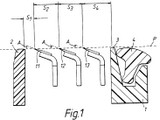
Gillette’s patent disclosing a three-blade razor also covers a four-blade version.
Gillette Co. v. Energizer Holdings Co. (Fed. Cir. 2005).
By Baltazar Gomez
Gillette owns U.S. Patent No. 6,212,777 for wet-shave safety razors with multiple blades. Gillette sued Energizer in the United States District Court for the District of Massachusetts alleging Energizer’s QUATTRO®, a four-bladed wet-shave safety razor, infringed claims of the patent. The district court denied Gillette’s motion for a preliminary injunction because it found that the claims covered only a three-bladed razor. On appeal, CAFC vacated the district court’s decision and remanded for further proceeding.
The ’777 patent claims a disposable safety razor with a group of blades, each blade placed in a particular geometric position relative to the other blades. Claim 1 describes a progressive blade exposure as follows:
A safety razor blade unit comprising a guard, a cap, and a group of first, second, and third blades with parallel sharpened edges located between the guard and cap… (emphasis added).
In determining the meaning and the scope of claim 1, the CAFC attempted to place the claim language in its proper technological and temporal context. The Court reasoned that the inventors’ statutorily-required written description in the patent itself, including the claims, the specification and the prosecution history, is the primary source of the meaning of disputed claim language.
Using this standard, CAFC determined that the language “comprising . . . a group of first, second, and third blades” can encompass the four-bladed Energizer razors. To begin, CAFC noted that the claim uses “open” claim terms “comprising” and “group of” in addition to other language to encompass subject matter beyond a razor with only three blades. Moreover, although the specification focused on blade units with three blades, the patent also disclosed a plurality of blades showing that the ‘777 patent covers razors with more than three blades. The CAFC further explained that it may be that a four-bladed razor may be less preferred embodiment, but noted that a patentee typically claims broadly enough to cover less preferred embodiments as well as more preferred embodiments, precisely to block competitors from marketing less than optimal versions of the claimed invention.
Further, CAFC also noted that the specification provided further support for interpreting claim 1 to encompass razors with more than three blades. The first sentence of the written description teaches that the invention relates to razors having a plurality of blades. Moreover, the prosecution of patents related to the ’777 patent also supports reading claim 1 as an open claim. Gillette endorsed an open interpretation of “comprising” when it argued to the European Patent Office (EPO) that a virtually identical claim in Gillette’s European counterpart to the ’777 patent would not exclude an arrangement with four or more blades. Accordingly, the CAFC concluded that the district court erred in limiting the claims of the ’777 patent to encompass razors with three blades because no statement in the ‘777 patent excludes a four-bladed razor.
In dissent, Judge Archer argued that claim 1 should not be construed as permitting a group with more than three blades simply because claim 1 contains the open transition term “comprising” in its preamble. Judge Archer concluded that a three-bladed razor is not merely a preferred embodiment of the invention, but is the invention itself, and that the inventors did not regard a blade unit with four blades arranged in the described geometry as their invention.
Note: Dr. Baltazar Gomez is a scientific advisor at MBHB in Chicago. Dr. Gomez obtained his PhD in biochemistry from the University of Texas and researched retrovirology as a PostDoc at Cornell University.